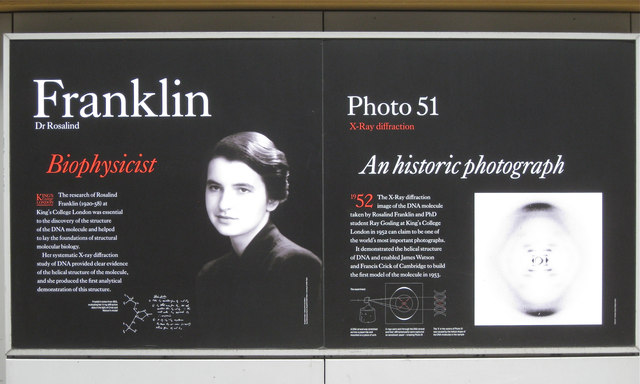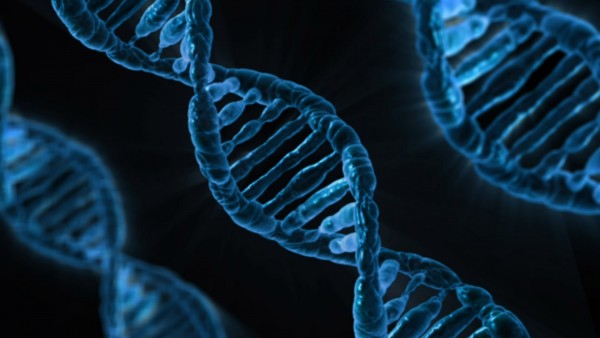A book about how James Watson and his sidekick Francis Crick won the Nobel Prize. Also there was Maurice Wilkins. Oh – and some woman who wouldn’t wear lipstick (but was handy with a camera).
On the surface, “The Double Helix” by James Watson should be right up my street. It is the autobiographical account of the discovery of the structure of DNA by one of the major players (and Nobel Prize recipients). It covers several areas I enjoy reading about (science, discovery, genetics, history), and all from a first person perspective.
I knew before I turned the first page that this would not be an entirely relaxing reading experience. I know the history of the process that led to the discovery of the structure of DNA. I’m well aware of the crucial, yet (at the time mostly) unacknowledged role that Rosalind Franklin’s photograph 51 played in aiding Watson and Crick’s understanding of the double helical structure of DNA. I’m also aware that this X-ray image was shared with Watson and Crick without Franklin’s permission, or even knowledge. So, I fully expected to find some sections of this autobiographical account a little on the difficult side.
Within two chapters, I had to put the book down. Although the first chapter’s description of Francis Crick (a man with a “quick, penetrating mind”, although “most people thought he talked too much”) was jarringly frank, it wasn’t until his first description of Rosalind Franklin that I found the book too infuriating difficult to read.
The section opens with a relatively unflattering description of Maurice Wilkins, then working at King’s College London, characterising him as unduly slow and cautious, and worse – distracted by his “assistant”, Rosalind Franklin (an unusual title for a post-doctoral researcher who has been awarded their own fellowship). He goes on to explain that this distraction has nothing to do with attraction (it is a crying shame that a trained crystallographer, hired with the instructions to take the lead in the efforts to obtain images of DNA chose not to “emphasise her feminine qualities”), but everything to do with (and admittedly what follows is paraphrased) her uppity ideas about her role in the team.

“Assistant” or Biophysicist? Information displayed on the outside of King’s College London’s Franklin-Wilkins Building paints a different picture
Watson seems positively surprised that a commitment to her career as a scientist could be anything other than the product of an unsatisfied mother who unduly stressed the desirability of professional careers that could save “bright women from marriages to dull men”. He also despairs at her frequent “belligerent moods” (it seems that she frequently complained about such menial things as men and women being forced to have separate break rooms; the women’s being dingy and pokey, while money was spent on making the men’s equivalent comfortable).
“When I had taken my ten deep and calming breaths (and admittedly had a break for a week) I returned – determined to finish the story”
From this early stage I could start seeing the shape of the picture that James Watson is trying to paint for the reader. Rosalind Franklin’s contribution was minimal (she was an assistant, according to Watson), although if she had been less difficult (“if she could only keep her emotions under control”), then “there was a good chance she could really help [Maurice Wilkins]”. However, her lack of flexibility (evident in her refusal to wear “lipstick to contrast with her straight black hair”, or take “a mild interest in clothes”) merely created an obstruction to Maurice’s efforts, at just the time when this poor man had the pressures of other scientists (one gets the feeling that this includes Watson and Crick) “breathing down his neck”.
Really, we’re led to the conclusion that if she had just been more womanly, flexible, and obliging then it would not have been the unfortunate case that “Clearly [she] had to go or be put in her place”. Indeed, as a reader, you can see how you are being tugged and pushed down a strange and thorny path, at the end of which Watson hopes you will agree that “the thought could not be avoided that the best home for a feminist was in another person’s lab”.
When I had taken my ten deep and calming breaths (and admittedly had a break for a week) I returned – determined to finish the story. I hoped that the following chapters would lead to some sort of redemption; unfortunately the overarching style of the narrative seemed to remain consistent throughout. Although it is hard to deny that the story has compelling elements, the style and majority of the content was hard to overlook.
Although most characters were not written about as negatively as Rosalind Franklin is (she continues to be painted as a scientifically misguided and overtly aggressive, unreasonable barrier to progress throughout), it is hard to think of any of the portrayals as flattering. Even Crick comes across as a slightly mad and often times difficult man whose great and flighty ideas are reigned in and refined by Watson.
In the build up to the final chapters, Watson has (or at least I assume he believes that he has) cast his play as follows:
Our Leading Men:
Enter, our hero, James Watson. He is a charming man about town who manages to intersperse his regular social calendar and woman chasing (no “faculty wives” though please) with an ingenious jack-of-all-trades approach to scientific problems. Without his keen insight and model building abilities, we would still be in the dark ages of genetic science.
His sidekick, Francis Crick. Francis is not well loved by staff or faculty at Cambridge, and doesn’t care. He is prone to wild flights of fancy, often highly critical of other researchers work. He is certainly crucial to the process, but without Watson’s firm and guiding hand would have been unlikely to concentrate for long enough to make any real progress.
Supporting Cast:
The reluctant ally, Maurice Wilkins. Although he was heading up the only English research team interested in the structure of DNA, he mistakenly hired a conniving assistant. This assistant was intent on keeping all of the work to herself and threatening Maurice both intellectually and physically (!), forcing him to join forces against her with our heroes.
The friendly rival, Linus Pauling. We know little about Linus, except that he is the primary competition in this race, and apparently brilliant. Until his double agent son arrives to work in Watson and Crick’s laboratory, his progress is mostly a mysterious black box. If not for an embarrassing error in his calculations, he would have published the first paper purportedly revealing the structure of DNA.
And finally…The villain, Rosalind Franklin. This uppity feminist not only refuses to behave or dress in an appropriately feminine way, she also insists on acting as if being hired and obtaining a fellowship to do serious post-doctoral research entitles her to do serious post-doctoral research. Worse, she does not agree with every idea put to her by our heroes – sometimes daring to think that the evidence she is fastidiously gathering may not support their hypotheses. Fortunately, her efforts do not stand in the way of our heroes, who manage to defeat her at her own game.

Artist Quentin Blake’s take on things [Source: https://www.flickr.com/photos/dullhunk/3965917511]
And so the stage is set for the final act. Enter our hero – Watson. He has recently discovered that the friendly rival in America has made a fatal error, and he is ready to swoop on the prize. So he arranges to meet the reluctant ally in his London headquarters. On his way to this meeting he wanders into the villain’s lair. He immediately realises his peril – and tries to soothe the beast with some (only slightly taunting) conciliatory banter. To his horror – she swoops and he is afraid for his safety until – thank goodness – the ally enters and manages to sooth the beast long enough for them both to escape with only a slammed door and bruised ego.
Whilst the two lick their wounds and recover, they bond over their close encounters with the villain’s wrath. It is clear that in such close proximity to the villain, the ally has no hope of reaching the end of the quest – and so he reveals the secret weapon to our hero, so that he might go on in his stead. It turns out the villain has carelessly and foolishly allowed an image providing evidence of the 3D helical structure of DNA out of her wicked grasp. Our hero immediately realises its significance and takes it back to his headquarters so that he and his sidekick can use this final relic to piece together the remainder of their quest…
“The book is written in an easy-to-read narrative style, and an almost impossible-to-read narrative tone”
And so it goes on. Obviously, I have taken vast creative license to recreate an exaggerated version of the narrative tone. That being said – the final few chapters describing the breakthrough that resulted in the Nobel Prize winning discovery of DNA’s helical structure really do seem to go out of their way to justify the primacy of Watson (and Crick’s) role in the discovery, and the total exclusion of Rosalind Franklin.
Overall, the book is written in an easy-to-read narrative style, and an almost impossible-to-read narrative tone. It is a short and interesting read about the dynamics and discoveries arising in this particular branch of scientific life at the time. It is also a very frustrating re-telling of history that seems to work very hard to actively paint certain players in the light that best suits Watson’s agenda, and retroactively attempts to justify his actions.
Verdict: Great read if you need somewhere to target your existential rage. Otherwise, read this or this for some great and interesting background reading about the structure of DNA and how it was discovered by a whole team of people based on a wealth of existing research.
Post Script: I should probably acknowledge that Watson adds an epilogue to his book where he is far more complimentary of Rosalind Franklin both as a human being and a scientist. Although he didn’t seem to feel the need to acknowledge her in any way in his Nobel Prize acceptance speech as far as I can tell from the transcripts. She does get a brief mention near the end of Maurice Wilkins’s address though…
[Ed. – when the author has managed to “get her emotions under control”, we’re going to buy her a copy of Watson’s follow-up: ‘Genes, Girls, and Gamow‘ – with a title like that, what could possibly go wrong…?]




Crick was rather more generous in his view of Franklin’s contribution: http://faculty.washington.edu/toby/doc/Crick.pdf